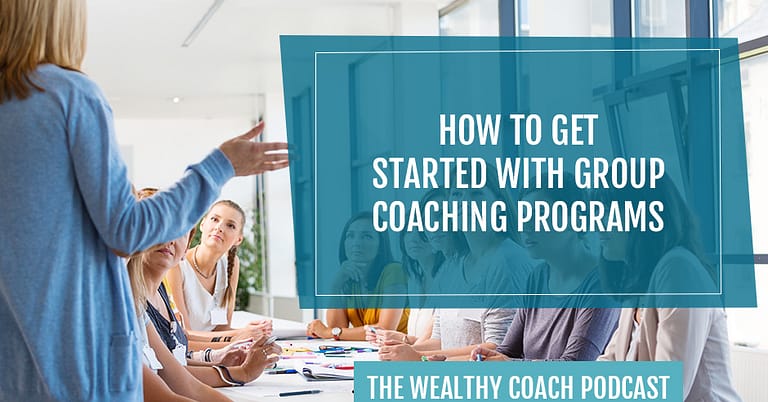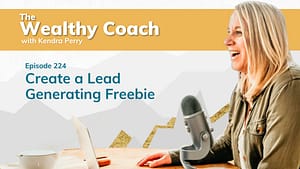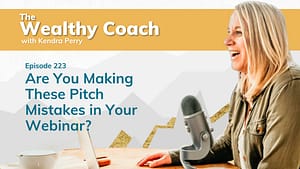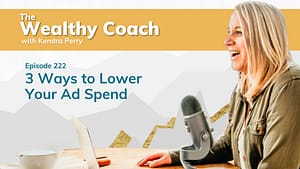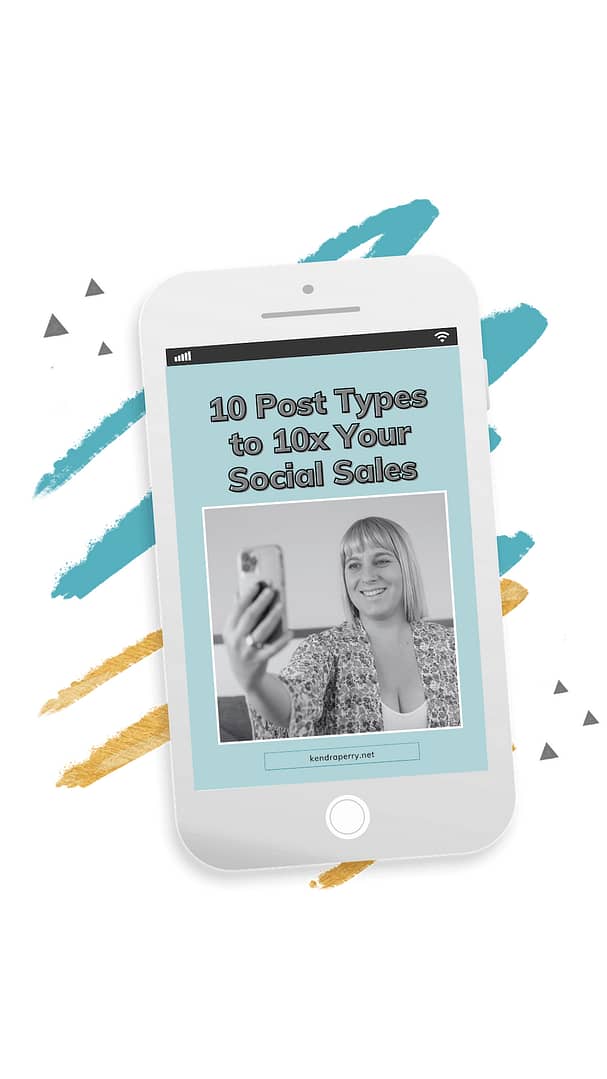There is so much to love about group coaching programs. If you implement it as a health coach, you get to spend less time in session per client and that leaves you with a lot more time to work on your business and yourself. But group coaching is also a hungry beast. You need to have all your ducks in a neat row in order to be successful. In this episode, Kendra Perry walks us through the five essential things you need to have in place before you launch your group coaching program. Strap on your seatbelt and get ready to learn about selecting a niche, growing an email list, creating pre-launch content, creating a unique methodology, and implementing an effective marketing plan. Tune in for all of these and everything in between!
Give this podcast a 5-star review: https://ratethispodcast.com/wealthy
Do you qualify to work with us inside HCA? DM my the word ‘biz audit’ to Facebook: https://facebook.com/kendraperryinc or Instagram: https://instagram.com/kendraperryinc and I’ll take a look at your biz and determine if HCA can help you launch your first online program and fill it with dream clients.
—
Listen to the podcast here
How To Get Started With Group Coaching Programs
Welcome back to the show. I’m pumped, stoked, and fired up. I’m happy to be with you here as always. I hope you’re having a good fall. At the time of this recording, we are going into October, which where I live is one of the most beautiful months of the year. We always get these hot, dry, sunny, and beautiful falls, which is amazing because once November rolls around, it is the worst month to be where I live because it’s dark, rainy, and too cold to bike. There’s not enough snow to ski. It’s one of those months where you get to do yoga, journal, and chill out, which is good too, but I love October because I love to get outside and bike, hike, and have a little bit of time in the sun before we go into those dark months, which is November to February.
Starting A Group Coaching Program
I’m excited to talk about group coaching programs. A question I get often is, “How do I get started with my group coaching program?” A lot of you guys are probably doing one-on-one. That’s where people start. I agree that one-on-one is a great place to start. I usually recommend when people are brand new that they start with one-on-one.
You don’t have to, but it’s way easier to sell a one-on-one program versus a group because as you can imagine, selling is hard. It takes a lot of effort to sell. When you have a one-on-one program, you just have to make that one sale versus when we’re talking about a group. Typically, a group is going to be at least five people, if not more. You time the amount of sales you need to get by 5, 10, 15, 20 or whatever.

You need an audience and more people in your world, in your audience, email list, and social media to sell a group program. When most people are starting a business, they come into it with no social media following or email list. Some people are different. Maybe you did a little bit of influencing or blogging. Maybe you shared a lot about your journey on social media, and you have a bit of a following or an audience, and that’s great. If you’re in that position, it’s going to be a lot easier to go into group coaching.
That transition from one-on-one to group coaching can be tricky, and it’s normal for it to be tricky. That’s because you increase the volume of sales you have to make. Sales is a hard thing to do. We need to physically get people to open their wallets, take out their credit cards, and give us the money they worked hard for, especially in 2023, where it costs $18 for a block of organic margin. I don’t know what inflation is like where you are at, but the organic margin I used to buy for $9 is now $18.99. If you have a minimum wage job, it’s an hour of work for that butter. Luckily, butter is high in calories. Hopefully, it’ll last you a while. Anyway, I digress here.
That transition is tricky. I don’t usually recommend that coaches who are brand new start with group coaching because it is trickier. That being said, some people are so averse to doing one-on-one, and that’s fine. They just have to understand that it’s going to take a little longer. The linchpin or the piece that does take time is the audience building. That can go slow or fast, depending on how motivated you are, how consistent you are, and whether you’re willing to invest in paid ads or not.
Group coaching is amazing. I love group coaching programs so much. From the day I started my business, I knew I wanted an online course. I didn’t realize that I would end up doing something that was this beautiful intersection between an online course and group programs. How I teach group programs inside Health Coach Accelerator is I teach people to make a hybrid in this intersection between an online course and a group program because that’s where the magic happens.
When I was new, I didn’t understand the concept of group coaching. I wanted this online course. I always knew I wanted, but I didn’t know how to get there. I didn’t necessarily know what I needed. It took me time. I had a lot of failures with launching. I had to do a lot of iterations. I had to make a lot of mistakes.
My intention for today is to lay out what you are going to need to get started with your group coaching program. Group coaching programs are the best because you get to serve more people. You get to make more money, and it takes the amount of time that you spend in session with your client. It reduces it in your schedule, which is great.

Some people incorrectly think, “With group coaching, I’ll be working less.” It’s not true. You’ll probably be working the same amount. It’s just that your time is spent differently. When you do one-on-one, you typically will spend less time marketing. You’re still going to have to market a lot, but you’ll typically spend less time marketing and more time in session with the client. The reason you spend less time marketing is because you need less sales.
If you’ve been following me and you are charging a penny-high ticket pricing for your program, you’re probably only going to need to find a handful of clients each month. The great news about that is you spend less time marketing. Sometimes, you can get to the point where you are wait listing clients in the future. This is where I got to with my private coaching program, where I was waitlisted about four months out. I didn’t have to spend that much time on social media or marketing because I was getting a lot of referrals. I knew that I had clients. I’d taken non-refundable deposits. I knew they were locked in four months out.
A lot of people think, “I don’t have a lot of time. I’m going to do group coaching because I don’t have a lot of time.” The truth is you’re going to need the same amount of time. With group coaching, you will spend less time in session with the client because you’re only going to have one group coaching call a week, maybe two, depending on how you run your program. That other time, it’s not just idle time where you get to do whatever you want. That time is spent marketing.
In group coaching, you spend less time in session with clients, but you spend more time marketing. In one-on-one, you spend less time marketing and more time in session with clients. A lot of people don’t realize that. The reason why you spend more time marketing with group coaching programs is because you have to make more sales.
Group coaching programs are a hungry beast with an insatiable appetite for clients. I don’t know why I’m using that analogy. It’s that you need more people, so you are always marketing. That is something to consider because if you love working with clients and being in session with clients, group coaching might not be right for you because you’re going to be spending less time in session.

I love group coaching because I spend less time in sessions with clients. I love supporting my clients. I only do it once a week. It’s a valuable experience for me. All that other time, I am marketing and preparing for promotions, but there’s way more flexibility with my time because I don’t have to show up at XYZ time to support XYZ clients. I can move those things around, get everything done in a day, and take a day off. For me, the flexibility is great. Now that I’m charging a good penny for my group coaching programs and courses, I don’t need to spend as much time marketing because I don’t need to find as many clients. Hopefully, this all makes sense.
Finding A Niche
I want to talk about the five things you are going to need to have in place to be successful in launching and filling a group coaching program. You’ve heard me talk about this a lot before, but I have to mention it again because otherwise, you might forget, and I would do you a disservice. That is a niche. You need a specific niche for a group coaching program. You don’t want to have a group coaching program that helps people with all kinds of different problems. The whole point of having a group coaching program is to allow you to scale, give you back more of your time, and help you make more money.
If you don’t have a specific niche for your program, you’re not going to be able to do that because you’re going to be spending all this time researching different problems and helping people with what they need help with. A group coaching program that is successful, this is also true for an online course, solves one clear problem. It’s not going to help people optimize their wellness, eat healthy, or improve their fitness. It’s going to help people solve one clear problem.

An example is one of my health coach accelerator students. Her name is Dr. Shannon Curtis, and she has a program that helps women clear their acne. She’s someone who previously struggled with her own acne. That was a good niche for her to choose. We will always do better, and it will always be easier if we choose a problem that we have personal experience with. That’s because we can speak to it more easily. Our story is a big part of our marketing plan.
I love this program, and Shannon has done incredibly well with this program because it solves one clear problem. Her program is bridging the gap between the problem they have and the solution they want. The problem they have is acne as an adult woman. I can’t remember the exact age group she helps, and the outcome or the result they want is clear skin. You’re going to want to pick one clear problem to solve.
I have to bring that up. I am the niche militia. It’s important. We’re talking about profitable niches. Something that can help is to choose a problem that is both chronic and severe. These are the most profitable problems to solve, not intermittent and mild. This would be the difference between a migraine, which is chronic and severe.
It’s a big problem. It interferes with someone’s quality of life versus attention headache, which comes and goes. You can take an Advil, move on, drink some water, and you’re good. We are looking to solve problems that are both chronic and severe. That is how you choose a profitable problem for your group coaching program. That’s number one.
Growing An Email List
Number two is an email list. You may already have one of those in place. This is important because when it comes to launching and filling a group program, it is a numbers game. There is a standard conversion you can expect to have. When I say conversion, it is the number of people who will buy. When you launch a program, it’s common to have a conversion of 1% to 5%. That’s the industry standard.
That means, based on the number of people who are in a launch, that might be the number of people on your email list or that might be the number of people who signed up for your webinar or free challenge. That means 1% to 5% of those people will convert into paying clients. I know 1% to 5% is a big variation, but that’s how it is. If you can get more than 5%, you’re above average. If you’re below 1%, you have some work to do, but most of us will start at the lower end, but that depends.
It’s important to know that because if you have an email list of 100 people to keep the math clean and there’s a conversion of 1% to 5%, that means you could launch and get one sale. That would all be within the realm of normal. That would be completely normal. That’s important to know. I wish I had known this when I started because I remember launching for the first time and making a few sales. It was way less than what I had anticipated, but knowing what I know now, I did okay. I should have kept going, but I was frustrated because I thought I was going to make twenty sales, and I made two. The conversion was good. I had a 2% conversion, but I didn’t know that.
This is important to know because you could have an email list of 100 and get one sale and think, “This doesn’t work. I’m a failure. This sucks. What the hell?” That is a good conversion. Can you improve that conversion? Absolutely, but a lot of us will start at the lower end. Even when you’re brand new, you might even get a 0.5% conversion. That’s normal because it’s new.
This is important to know because when we think about launching a group program, we want to make sure we have enough people on our email list before we launch. There isn’t a magic number because conversion can vary significantly. Conversion is not guaranteed. Just because it’s typical to get 1% to 5% doesn’t mean you’re going to get it. You could get 0%. You have to know what you’re doing. You have to have good messaging. You have to have well-written emails, a good sales page, a webinar, a challenge, or something to spike that engagement and excitement around the program and the launch. It’s not always guaranteed.
There isn’t a magic number, but I tell my HCA students that they should probably have between 300 and 500 people on their email list before they launch. If they have 300 people on their email list and they get a 1% conversion, that’s 3 people. Ideally, we want 5 to 10 people to run a group coaching program, but 3 is enough. It’s a group. It’ll work. If you get 2%, you’ll have 6. If you get 3%, you’ll have 9. Three hundred is the minimum but again, it depends. You want to make sure you are building that email list.
This is the reason why it’s hard for people who are brand new to start with group coaching because typically, they’re starting from zero. They don’t have the email list. They might have a small social media following. You might be wondering, “Can I launch to my social media following? Doesn’t that work?” This can be problematic because only 1% to 2% of your followers tend to see your content. You don’t have much control over who sees it and who doesn’t. Someone could see your content one day and not see it for another week, but then the launch is over.
Instagram, Facebook, and social media platforms, in general, recognize when you’re being promotional. They want you to pay for promotional content, and they need to protect user experience. If they allowed everyone to be promotional all the time on social media, it would ruin user experience, and no one would want to be on there.
Imagine every time you went on Instagram, all you saw was people promoting content at you, like promoting their programs and products. You’d be like, “This sucks.” It’s a delicate balance. When you are promotional on social media, you tend to lose reach, and those posts tend to reach fewer people. I’m not saying you shouldn’t rely on social media. You can use both your email list and your social media, but it’s not good to rely on it alone.
We want to have that email list. The reason is we have control. We can guarantee that an email is going to end up in someone’s inbox. We can’t always guarantee it’s going to end up in their primary inbox. It could end up in the spam or Gmail promotions tab, but there are steps we can take to make it more likely that it is going to end up in that inbox.
Creating Pre-Launch Content
The other thing is email open rates are high. You can get an email open rate of 30% or even more. That’s fantastic. It is way better than 1% to 2%. That’s a magnitude higher. You do want that email list. There are a lot of different ways you can grow an email list. The most obvious and easiest way is to create a good free resource. Offer it for free in exchange for a name and email address. You want to make sure you are nurturing that email list regularly, which brings me to number three, which is pre-launch content. This is important.

I remember speaking with a student. This may have been a year ago or more. She wanted to launch a group coaching program. I believe it was about maybe the end of May. She wanted to launch this thing in mid-July. It was about a few weeks out. I was like, “That’s a quick timeline. Do you have anything made?” She’s like, “No sales page and emails.”
I’m like, “That’s a quick timeline. Usually, you want a little bit more time to prepare because there are a lot of things to do. How many people are on your list?” She was like, “This many.” I’m like, “Have you been communicating with them regularly?” She said, “No, I haven’t emailed them since January.” Remember, this is May, and she had not emailed them for a few months.
I was like, “This is not going to be successful because you have not interacted with these people. You haven’t sent them an email. There’s a good chance that when you start sending your launch emails, it’s going to end up in their spam. A lot of them are going to have forgotten who you are. They’re not going to know who you are. What you’re going to be doing is something I call surprise launching on your audience, which you never want to be doing.”
A lot of people put all this focus on the actual launch. The actual launch is the open carts from the time the program is available for purchase to the time when the doors are closed, and they can’t purchase it anymore. A lot of people put all the weight on that, but that’s the least important part. The entire success of your launch is based on your pre-launch content because you need to warm people up and get them ready to buy. A pre-launch depends on what you’re selling and how much it is. For example, if I’m selling a $50 workshop, then my pre-launch might be two weeks.

If I’m selling a $2,000 or $3,000 program, I’m going to have a longer warmup period. It’s maybe 2 to 3 months. It depends on the price point. What you want to be doing during that time is you want to be sharing relevant content that is aligned. It should all be focused on the topic of the group coaching program. On top of that, you also want to be telling people that you’re going to do it.
This is something I’ve seen a lot with my students where they want to keep it secret. They’re like, “I want to keep it secret. I want it to be this big announcement.” You don’t want to do that. You want to tell people well in advance what you’re up to, “I’m going to be launching this group coaching program. This is coming up.” You can show some behind-the-scenes of you working on it. You can prepare people for what you’re about to launch. When you launch it, they know what’s happening. They’re not surprised. Possibly, they’re even ready to buy, and they are anticipating it.
Something I teach my HCA students to do is create a waitlist. You can do this with a simple opt-in form with whatever landing page software you’re using. You can create a waitlist for a new program. This is something that I always used to do when HCA was a live program. HCA is ongoing enrollment. People can enroll. There’s no specific start date or end date, but for the first 3 or 4 rounds, it was a live program.
I highly recommend that you start that way because it’s easy to learn a lot about a program when it’s live. You can get a lot of feedback. There is going to be a lot more engagement and interaction versus ongoing enrollment. You lose a lot of engagement when it’s ongoing enrollment. For those first round or two, it’s always good to do it live if possible. I know that’s not going to be possible for everyone, depending on schedules. Doing the first version live is incredibly valuable.
What you can do is you can create a waitlist. That can be one of your primary calls to action in your social media post when you send an email to your email list. You can say, “I’m going to be launching this program in this timeframe. If you want to get on the waitlist, you can do that here.” Make sure to give them an incentive to be on the waitlist because no one wants to be on a waitlist. If you tell them, “You’re going to get early access, and you’re going to get a discount that won’t be offered elsewhere,” people are going to be more likely to join the wait list because they’re like, “I’m going to get an additional bonus.”
How I used to do this with my launches is 24 hours in advance, I would open up the program to the VIP list. I give them some special extra bonus. I’d give them a coupon code or something that gave them an extra $100 or $200 off. I was like, “You got 24 hours to take advantage of this, and the price is going up.” That is something that will make people take action. It also incentivizes people to join the VIP list.
You’re going to want to make sure you are emailing your list regularly, at least once a week, but it can be more. I email my list three times a week. You’re going to want to be sharing that relevant content on social media. You want it to be very aligned and relevant to the topic that you will be teaching in the group coaching program.
Creating A Unique Methodology
Number four is a unique methodology. This is something I also teach inside HCA. It is the step-by-step framework that you teach inside your program. This is what I meant when I was saying earlier about this intersection between an online course and a group coaching program. When we think about an online course, we think about modules and a framework. We’re teaching this step-by-step thing.
A lot of times, when people think about group coaching programs, they think about something where people may do an intake. They get a protocol. They’re showing up on group coaching calls, and everyone’s getting coached at the same time. Maybe there’s a community. In my first group coaching program, this is how I did things. I brought a bunch of people into a group. I had them run labs and complete an intake. I gave each one their individual protocol. If they needed coaching, had questions, concerns, or struggles, they showed up to the group coaching calls or asked questions in the Facebook group.
This worked, but the problem is I made myself the linchpin in the program with my student transformation. What I mean by that is they couldn’t learn or progress without me because if they had struggles or needed to know how to do something, they needed to come onto the coaching call or be in the Facebook group. They always required me.
I wasn’t able to grow this program big. I had twenty people in it at one point. That was a lot for me because I was creating plans, updating plans, and answering all kinds of different questions. What I realized and did is I ended up creating a framework or a course that lived inside the group coaching program that took them from A, B, to C.
Something that I learned, and you may have also learned as well, is people need a lot of the same things. We like to think that all our clients are uniquely different and require different approaches, but truthfully, that’s not true. There’s a little bit of uniqueness. If we are focusing our group program on one specific topic, people all need the same thing.
At the time that I was running this group program, I was high on energy. I was focusing on helping women reverse chronic fatigue. I realized, “They all need to be eating this diet. This is how they should be exercising. They need to reduce stress and detoxing.” I created a curriculum or a step-by-step method. Instead of people coming into the program, not knowing what next steps to take, having to wait for their protocol, and needing to ask me every time they didn’t understand something or they had questions, they came in and progressed through the course.
There was still customization. We still had them run labs and created protocols for them, but we didn’t need to create an intense or elaborate protocol for them because they could go through the module. This is your unique methodology, and this is the intersection between group coaching and an online course, which is amazing and perfect for the health and wellness industry because health and wellness courses offer no support. They can be effective but most people aren’t going to get results within that because health is unique, and people don’t always react the same to different protocols.
If you have been working with clients for some amount of time, you might notice you’ll recommend one seemingly inert thing to one client. They don’t feel anything. You recommend it to another client, and they get some crazy reaction. It’s normal. Everyone’s body is different in that way. When we offer DIY or courses without a lot of support, the client doesn’t tend to get the same result versus when they have the support.
With group coaching and community, they can progress further and get their program tweaked. They can get recommendations, feedback, and coaching. They can get their concerns addressed. That’s why I think a unique methodology is critical to group coaching. This is something we also teach inside the Health Coach Accelerator.

Creating A Marketing Plan
Number five is really important. A lot of people don’t think about this, but this is the marketing plan. How are you going to market? If you remember, at the beginning of this episode, I told you that if you are going to go the route of group coaching, you spend more of your time in marketing and less time in session with clients. That’s because we need to make more sales. Therefore, we need to market more.
There’s a bunch of different ways you can market your program. Social media is one of them, and paid ads. Typically, we are going to need some sort of event, either automated or live, to sell the program. It depends on what type of program you have. Some people like to run live group coaching programs where the program has a start date and end date, and maybe only runs once or twice a year. You can do that. Some people want ongoing enrollment. The program is always available. People have different start dates, and they can enroll at any time.
With a live program, the marketing plan is relatively straightforward. In between launches, you are going to be sharing relevant content, warming up your email list, and driving people to a waitlist for the next round. If you have ongoing enrollment, you’re still going to need a marketing plan. A lot of people, when they have an ongoing enrollment program, they want to evergreen it or automate it. There’s some automated event like a webinar or something that sells people into a program.
That can work but it’s difficult. Sometimes, it can take a lot of time to optimize. It depends on how good you are at copywriting, messaging, and conversion. Something that people don’t realize is when you automate something, the conversion goes down. With something automated, a good conversion is about 2%.

What I mean by that is if you have an automated webinar. As an example, I have a webinar that sells HCA. You can grab it. It’s in the show notes for this episode if you want to check it out. I will go over in a little bit more detail everything you need to have an online coaching program. In the end, I sell HCA. The conversion for that, a good one is 2%. For everyone who signs up for the automated webinar, about 2% are going to enroll and convert. A lot of people don’t realize that. If I did that webinar live, I might be able to get as high a conversion of 10%. It’s pretty good. Whereas with automated, I usually get about 2%. You can see there’s a big difference there.
When you automate everything, the thing you need is traffic. A lot of people don’t realize this. They’re like, “100 people went through my webinar this month and I only got one sale.” One percent is not bad. It’s close to 2%. It’s in that realm of normal. They think this doesn’t work when they just need more traffic. Traffic is tricky because if you’re doing organic content, you have to be hustling hard on social media, or you need to be paying for it, which is great. You can also pay for it.
A lot of people have to understand that about anything automated. It’s that the conversion is much lower. You are going to need to invest in paid traffic or create more content. A lot of people will still need to live launch. Usually, what works best for people is having a combination of something automated. A way to get people in all the time could be an automated webinar or you going hard in the DM or content and having some live event that you do maybe quarterly, every two months, or monthly, depending on how much new traffic you’re bringing into your business every month.
That launches it. That could be with a webinar, a free challenge, a workshop series, or a summit. Generally for the Health Coach Accelerator, this is my marketing plan. I have an automated webinar that sells people throughout the month, but every 2 to 3 months, I do some live event, whether it’s a webinar or the free challenge that I did last week to create a little bit more buzz and warm people up to me a little bit more quickly because they have a little bit more time with me. You are always going to get that higher conversion with a live event.
With my program HTMA Expert, I only have an automated funnel for that one. That one works well. It is automated only. I have a high conversion for that. I believe that’s because I’ve developed a lot of authority in the space. I created my program many years ago. It was one of the first, and it’s also hyper-niched. I don’t have much competition. That’s always going to make things a lot easier.
Let’s do a quick summary and break down everything you need to have a successful group coaching program. You’re going to need that specific niche. You want to make sure your program is bridging the gap between problem and solution. You want to have your group coaching program solve a problem that is both chronic and severe.
2) You are going to need that email list. I recommend 300 to 500, so at least 300 before you launch. If you only have 100, get to work and build that email list. 3) You’re going to need that pre-launch content. That content is going out to both your social media and email lists. It’s relevant, intentional, and aligned with what you teach inside your group coaching program. You want to make sure you are letting people know that your group program is coming and driving people to the waitlist.
4) Your unique methodology or that step-by-step framework that you take people through when they come into your program. It’s the course that lives inside your group coaching program. 5) The marketing plan. For most of us, it’s going to be a combination of evergreen, something that sells all the time, and something live that you do every 1 to 2 months.
I hope you enjoyed this episode. I would love it if you could give me a five-star review on iTunes. That is possibly the most generous thing you can do for all this free content I give to you each and every week. You can do that by going to RateThisPodcast.com/Wealthy. One more thing I want to let you know about that I’m excited about is I am going to be doing a five-part podcast series. It’s going to be called Master Your Marketing. That is going to happen on October 30th through November 4th, 2023.
I’m going to be dropping an episode every day on how to master your marketing. That is coming up in a couple of weeks. I get excited about that. I’m pumped. There’s nothing to do. You don’t need to opt in. Make sure you are subscribed to this show, and you’ll get that notification when the episodes go live. I will see you in the next episode, same time, same place, where I help you become wealthy AF.
Important Links
- iTunes – The Wealthy Coach
- RateThisPodcast.com/Wealthy
- https://Facebook.com/kendraperryinc
- https://Instagram.com/kendraperryinc

